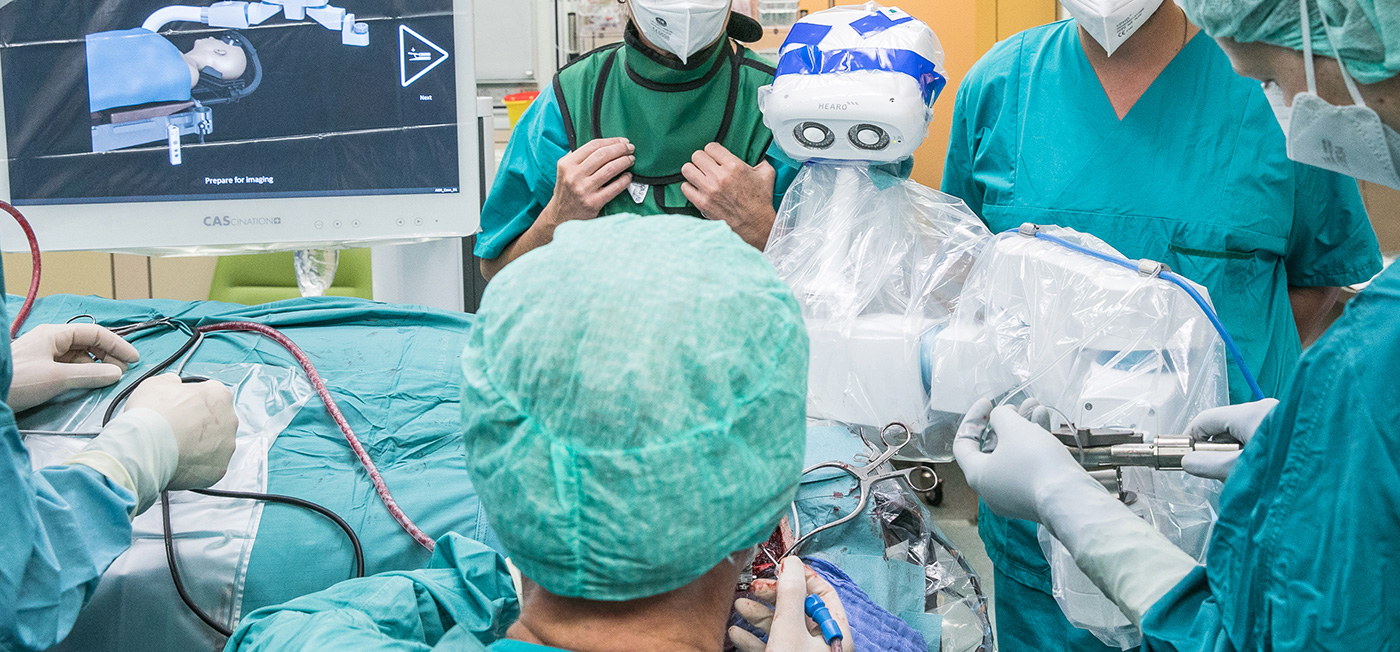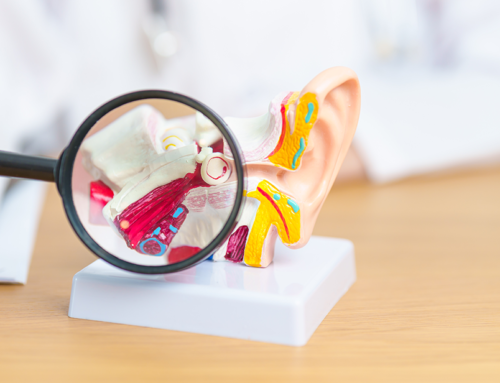HEARO – a pioneering performance in a CI surgery
In September, the first robot-assisted cochlear implantation in the German-speaking area took place in Vienna. The surgeon Prof. Dr. Wolfgang Gstöttner was assisted in accessing the inner ear by HEARO, a special surgical robot for cochlear implantations.

Green stands for “clean” in the operating area. Everything what´s sterile and should remain so is covered with green cloths: for example, the instrument table with forceps, clamps, scalpels and drills and various devices prepared for their use with sterile clear covers. The surgical team also wears green robes and slippers. And finally, the operating table is covered in green.
The so-called “table,” which is actually a couch whose center of gravity rests on a square column base can be tilted in all directions and bent several times. This way, the patient can be placed in the optimal position for the operation in question.
September 17, a fifty-year-old man lies on the table under general anesthesia. He is secured with wide belts so that he cannot slip off and he is also covered with green cloth. The only visible area is around his ear where the operation is to be performed: the insertion of a cochlear implant. Three mighty articulated arms project from the ceiling into the room and they each carry one of the large surface lights that illuminate the patient and the surgical area. In the background, there is a monotonous beeping sound that comes from the devices that monitor patient’s heart and breathing during anesthesia.
Robots in the CI operating room are new
If the microscopes were not missing, the operating room at the Vienna University Hospital AKH would resemble its usual appearance at the beginning of every cochlear implantation. Instead, a CT machine is waiting in a corner and additional computers are ready on small mobile tables. They will be used for planning, controlling the surgical robot and final testing in the first robot-assisted cochlear implantation in Vienna.
While robot-assisted surgery in orthopedics has been possible since the 1990s, HEARO was the first robot used for a cochlear implantation in Bern, Switzerland, in 2016. “After two decades of experience in neurosurgery and ENT, we still have several millimeters of deviation with conventional navigation systems,” explains Prof. Wolfgang Gstöttner, MD. However, in cochlear implantation fractions of millimeters are important to protect nearby blood vessels and sensitive nerves. This requires higher accuracy and reliability than in orthopedics.
The HEARO CI robot, in combination with CT imaging and facial nerve monitoring, provides this accuracy and reliability. This is the result of 10 years of development by CAScination and MED-EL, together with scientists and clinicians.
One arm and two sensors
First, the patient is carefully positioned on the operating table: his head must be placed in such a way that the CT scanner can later rotate around it without touching it. After that, the individual parts of the HEARO robot are positioned. The arm will later guide the drill. The most sensitive part of HEARO is the camera. As soon as it points its two sensors at the patient’s ear, HEARO is reminiscent of Wall-E, the robot from the Pixar animated film of the same name, which is there to clean up the chaos on Earth.
Before HEARO “clears the way” for the electrode, it must be ensured that its navigation is reliable. The starting point is a model made of black-gray 3D printing that represents the patient’s bone. Pin needles shine in blue, marking the favorable points for robotic navigation. “This will be the future for all CI patients,” speculates Prof. Dr. Christoph Arnoldner, who is assisting in the surgery. The surgeon is Prof. Dr. Wolfgang Gstöttner. He begins the operation with a short cut of the scalpel, pushes the skin aside a little and sets the markings. The staff that controls the CT scan prepares for the surgery, wearing radiation protection.
You have to have faith
Next, the work is done in groups. Prof. Gstöttner prepares the implant bed, where the electronics of the implant will later lie securely. A team of technicians takes care of the data from the CT scan. At the other end of the operating room, technicians are already starting the OTOPLAN program on a computer.
OTOPLAN, which is also a product of CAScination, is a special DICOM viewer. This means that it displays the data from CT examinations in two-dimensional sectional images and three-dimensional models. For cochlear implantation, OTOPLAN can help select the appropriate electrode already in the planning stage. For robot-assisted implantation, OTOPLAN calculates the exact and optimal approach. This data is sent to HEARO.
And then, the big moment: the words “HEARO-Surgery” appear on a screen near the operating table, with a start button icon below it. The most sensitive part is the initialization that must be carried out at the beginning. If the procedure is disturbed, for example, by a violent movement near the operating table, it is repeated for the sake of safety. In each case, the screen shows the current progress and instructions for the next steps. After quite a few clicks, the robot’s arm moves to the patient’s skull. ”
After that, the surgeon has no way to intervene, except to completely stop the operation. This is a new step, which was a bit foreign to me,” CI specialist Gstöttner describes this moment. In the operating room, he can now cross his arms in a relaxed manner: “It’s like a mountain climbing: from the moment you hang onto the rope, you must trust the rope.” Using pedals, he controls the robot, which independently drills a channel for the electrode. “This is very different from some other robot-assisted systems, where only the surgeon´s hands will get translated using the robot.”
Minimally invasive access to the inner ear thanks to HEARO
The robot drills into the bone with control, slowly and gently. It only pauses briefly for a control CT, and then continues. In case of cochlear implantations, the associated heating of the human bone during drilling and milling usually produces a typical odor. Only a few minutes later, the electrode channel is ready and access into the cochlea is free.
Instead of a relatively wide-open middle ear to the connection to the inner ear, HEARO leaves only a 1.8-millimeter slim hole from the skull surface to the cochlea, through which Prof. Gstöttner inserts the electrode. This is where the large microscope comes into play, which has meanwhile been moved back into the operating room. Telemetry and a final CT scan confirm the function and correct positioning of the implant and electrode. Later, during system activation, the CT image can help to optimize the frequency distribution when programming the audio processor.
The monotonous monitoring signal from the anesthesiologist’s equipment still beeps in the background while surgeon Prof. Gstöttner closes the wound. “For young surgeons, it is not bad to still learn conventional cochlear implantation,” Prof. Gstöttner will later advise his colleagues at other clinics. For everyday clinical use, HEARO still seems too time-consuming and personnel-intensive to him. “But it is a glimpse into the future of cochlear implantation.” A future that has already begun at the Vienna University Hospital – AKH.
Robot-assisted cochlear implantation with HEARO
During the cochlear implantation on September 17, 2021 under the direction of Prof. Dr. Wolfgang Gstöttner at the University Hospital of Vienna, the CI robot HEARO also performed the cochleostomy – the opening of the inner ear. This was new not only for Austria, but for the entire German-speaking region! During the development phase of HEARO, nine implantations had been performed at the University Hospital of Bern in Switzerland, but the surgeons had always opened the cochlea. After HEARO’s CE certification in 2020, surgeries followed in Antwerp, Belgium, and finally, in Vienna.
HEARO will not replace the surgeon or the surgical team. The robot will always be controlled and steered by the surgeon and the CT device and OTOPLAN software will have to be handled.
The preoperative planning for HEARO-CI surgery is complex, but very precise. Three low-dose CT scans are performed during the operation. Drilling the electrode channel with HEARO only takes about ten minutes. However, due to the precise preparation before the surgery and the control stops during the surgery, the overall surgery time with the robot is longer than with conventional cochlear implantation.
“Most importantly, the HEARO procedure allows surgeons to open a minimally invasive approach to the cochlea and take the ideal route for complete insertion of the atraumatic electrode array into the cochlea,” said Dr. Ingeborg Hochmair, CEO of MED-EL. This tiny hole reduces the surgical impact on the patient and increases quality and safety.
For more information on HEARO and OTOPLAN, visit www.cascination.de, www.medel.pro/products/otoplan, the MED-EL Germany You-Tube Play-List OTOPLAN and the corresponding episodes of the podcast https://podtail.com/podcast/med-el-podcast/.






